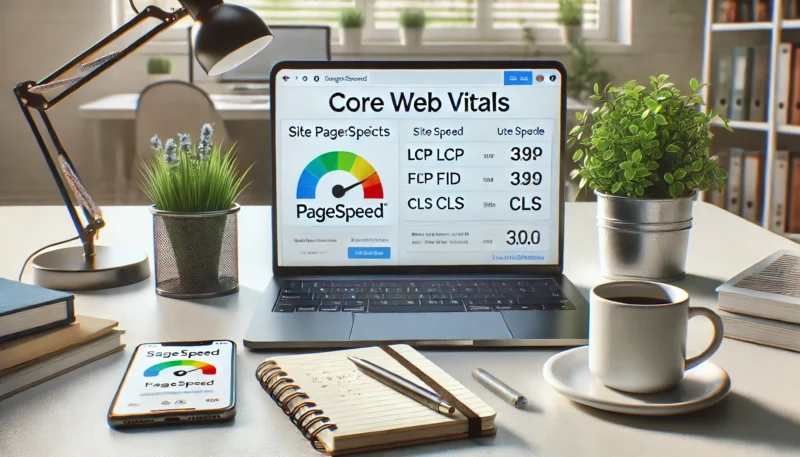If you want your website to rank well on Google in 2025, you need more than good keywords and backlinks — you need great user experience. That’s where Core Web Vitals come in.
Introduced by Google as part of the Page Experience update, Core Web Vitals are a set of performance metrics that directly impact your search rankings. They measure how fast, stable, and interactive your pages are — especially on mobile.
In this guide, you’ll learn what Core Web Vitals are, why they matter for SEO, and how to improve them step-by-step.
What Are Core Web Vitals?
Core Web Vitals are three specific metrics that Google uses to evaluate a webpage’s user experience:
1. Largest Contentful Paint (LCP)
What it measures: Loading performance
Target: Under 2.5 seconds
Example: The time it takes for the largest image, block of text, or banner to load.
2. First Input Delay (FID)
What it measures: Interactivity (how fast your page reacts to the first user action)
Target: Less than 100 milliseconds
Example: Time between a user clicking a button and the page responding.
🔔 Note: In 2024, Google began replacing FID with Interaction to Next Paint (INP) as a more reliable interactivity metric.
3. Cumulative Layout Shift (CLS)
What it measures: Visual stability
Target: Less than 0.1
Example: Elements shifting while a page is loading (e.g., buttons moving as you try to click).
Why Core Web Vitals Matter for SEO
✅ Ranking Factor
Since 2021, Core Web Vitals have been part of Google’s Page Experience update, making them a confirmed SEO ranking signal.
✅ User Experience
Better performance = happier users = more time on site, more conversions, and lower bounce rates.
✅ Mobile-First World
Most traffic today comes from mobile devices — and Core Web Vitals are heavily weighted on mobile performance.
How to Check Your Core Web Vitals
Tools You Can Use:
-
PageSpeed Insights (Google)
-
Lighthouse (Chrome DevTools)
-
Google Search Console > Core Web Vitals Report
-
WebPageTest.org
-
GTmetrix
✅ These tools show both lab data (simulated) and field data (real-world user metrics).
How to Improve Each Core Web Vital
🕒 1. Largest Contentful Paint (LCP)
Goal: Improve loading speed
Actionable Tips:
-
Optimize and compress images (use WebP format)
-
Use faster hosting and a CDN
-
Remove render-blocking resources (CSS, JS)
-
Minimize third-party scripts
-
Prioritize critical content with lazy loading
⚡ 2. First Input Delay (FID) / Interaction to Next Paint (INP)
Goal: Improve responsiveness
Actionable Tips:
-
Minimize JavaScript execution time
-
Break long tasks into smaller chunks
-
Use web workers for background tasks
-
Defer non-essential scripts
-
Reduce the impact of third-party code (chat widgets, analytics)
📐 3. Cumulative Layout Shift (CLS)
Goal: Improve visual stability
Actionable Tips:
-
Always set height and width for images and videos
-
Reserve space for ads and embeds
-
Avoid inserting elements above existing content
-
Use fonts that load quickly or with fallback fonts
-
Preload key assets like fonts and banners
Bonus Optimization Tips
✅ Use a Performance-Optimized Theme
Lightweight themes improve Core Web Vitals out of the box.
✅ Leverage Caching Plugins
Plugins like WP Rocket, LiteSpeed Cache, or W3 Total Cache can dramatically boost performance for WordPress users.
✅ Use a Content Delivery Network (CDN)
CDNs reduce load times by delivering content from servers closer to your users.
✅ Avoid Heavy Page Builders
While convenient, many drag-and-drop builders add bloat. Use clean code where possible or lightweight alternatives.
How to Track Progress Over Time
Once you’ve optimized, continue to monitor performance in Google Search Console and PageSpeed Insights.
Set a schedule to:
-
Audit key pages monthly
-
Track improvements or regressions
-
Update your CMS, themes, and plugins regularly
Final Thoughts: Better UX = Better SEO
Core Web Vitals are about more than just satisfying Google — they’re about building a better experience for your visitors.
Faster load times, smooth interactions, and stable layouts increase trust, engagement, and conversions. And yes, they also improve rankings.
So if you want long-term SEO success in 2025, make Core Web Vitals a central part of your strategy — not just a checkbox.

